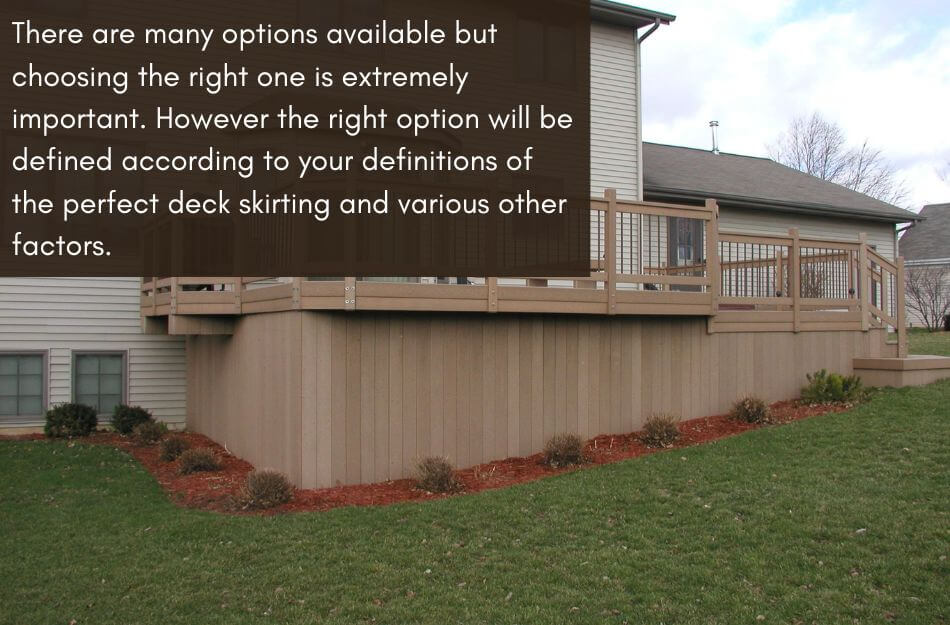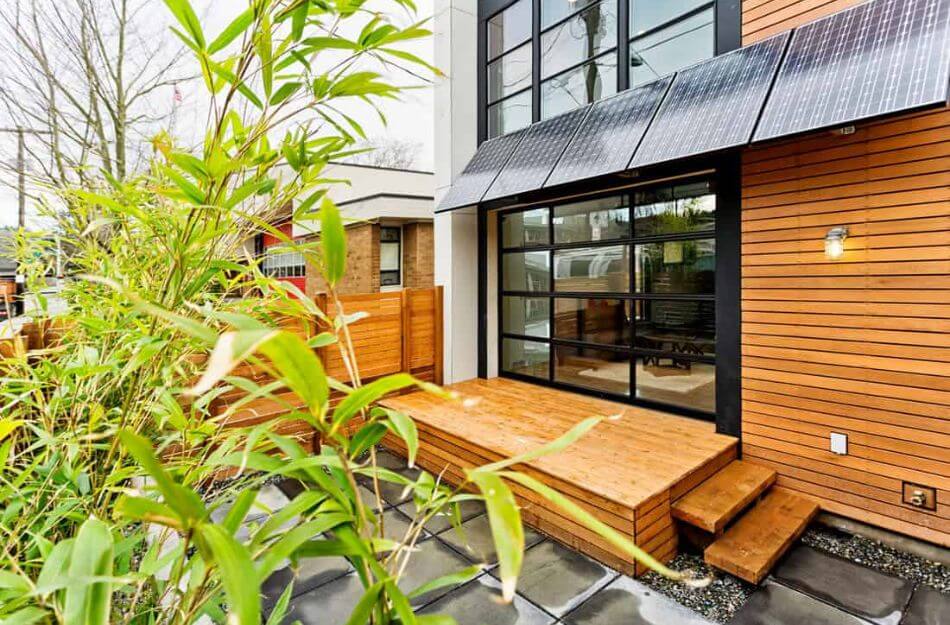Skirting a deck is a component of the deck’s general design. It keeps undesirable animals out while enhancing the deck’s durability and aesthetic allure.
Picking the best deck skirting option depends on your tastes and the skirting’s intended use.
There are many options available but choosing the right one is extremely important. However, the right option will be defined according to your definitions of the perfect deck skirting and various other factors.

Table of Contents
Deck Skirting Designs & Materials
Matching or enhancing the design of your deck is essential for selecting the ideal deck edging.
Achieve a feeling of consistency from the peak of the fence to the bottom, which typically entails using the same material throughout. The elements used for deck skirting are as follows:
- Solid wood
- Wood lattice
- Faux stone
- Composite materials
- Bricks
- Metal
- Plants and shrubs
Many contemporary deck owners, however, stray from this standard and choose skirting materials that are striking or in contrast. It’s ultimately up to you to make a choice.
Also Read: Deck Block Vs. Post Holes: Which Is Better?
Lattice
The most popular type of skirting is presumably made of lattice panels called deck skirting. Aluminum, plastic, or timber are the traditional materials for deck skirting lattice.
While wood lattice is occasionally less expensive than plastic, it remains less durable. The cost of wooden lattice tends to differ depending on the type of wood used.
You can order custom-sized lattice panels to suit your requirements from a direct seller or purchase ready-made panels from a home improvement store.
The lattice pattern is dependent on the desired design appearance. There are square compartments (vertical and horizontal lines) and diamond cells for lattice screens (diagonal lines).
Solid Wood
Another common and adaptable choice for deck skirting is solid wood boards. Installing the planks vertically will give the appearance of height to a short deck.

You can get as artistic as you like by installing the boards longitudinally to give the deck a much more rustic feel. You can also do it by incorporating lattice work between the panels for a more classic appearance.
See Also: How To Seal Pressure Treated Wood?
Under the Deck
Depending on your available room, an underdeck is a great place for several uses. Using this area as outdoor storage for items like lawnmowers, pool tools, outdoor furniture, and other things that will only work in the garage.
Regular siding that resembles the remainder of your home is an option.
For more airflow, use a lattice design. If the space is big enough, you could put in a garage-style door that mimics the deck boards and railings wood.
Install a deck sewage mechanism and an underdeck roof beneath the deck planks if you intend to store items underneath the deck that need waterproofing.
If not, water from rainwater will seep into your storage area through the decking boards’ gaps. Mildew and rotting can result from trapped dampness.
Metal
Utilizing sheet metal for your deck edging will complement your overall aesthetic if you want an industrial or modern look. Metal can be used in inventive ways besides as a deck skirting substance.
Sheet metal can be shaped into latticework or other beautiful or imaginative designs. Metal deck skirting is very adjustable because you can also color it.
Be aware that you must use rust-resistant metal if you choose to use it for your deck edging.
Plants
Plants are an especially adorable way to cover up the bottom of your deck. You can generally make deck skirting ideas by planting bushes or shrubs in the ground around your deck.

It is comparable to erecting a fence to surround your house.
It is a creative method to make a deck skirt, but it can require a lot of upkeep. The plants will need frequent trimming in addition to being kept alive and healthy.
Stone
Stonework can be used to fashion a traditional and elegant deck skirt. You can use any stone, whether stacked, big, or irregularly shaped.
Despite being among the more expensive choices, this one has great aesthetic appeal, particularly when combined with a porch or deck made of natural wood.
Even simpler to work with faux stone is available if you like the appearance of a stone wrap yet want to cut costs. It simplifies installation and helps you get the look you want for much less.
Painted Beadboard
Beadboard might be the ideal material for this endeavor if you like the appearance of crisp vertical lines.
To clean the above area, look for a sturdy beadboard made for outdoor use and install it all over the outer borders.
It will look lovely and tidy in this space if you color it white. It’s simple to locate and deal with, and you can paint or stain it to either match or contrast beautifully with your current furnishings.
Black Vinyl Lattice
Making your deck stick out with skirting can be done by using a black vinyl lattice underneath. It contrasts sharply against other design hues, like its frequently used companion, white lattice, allowing for some intriguing combinations.

It’s also very simple to set up; maintaining it takes little work.
This wraparound porch employs black vinyl to contrast the bright whites, muted grays, and browns of the existing structure.
It matches the glass windows on the house and blends in with the area underneath rather than drawing attention to itself.
This design deviates from the conventional cell structure by employing a more intricate latticework. Additionally, the underside is left unframed, making almost the entire area viewable.
This lattice adds a layer of complex design that serves as a subtle accent and goes nicely with the black deck railings.
You May Also Like: How To Stop Water Pooling On Decking?
Outdoor Area
Lattice could be your best option for skirting if the area in which your deck is located has a slight slope or inclination. You can cut the bottom of your lattices to match the level where it touches the ground.
For instance, this deck has a gate entrance installed to allow entry from below and is framed with a white lattice to fit the ground’s downward slope.
Another great solution uses stone bricks. Though lower to the ground and covering less space, this deck fits wonderfully with the rest of the house, allowing for a seamless transition between the deck and the backyard.
To suit an uneven ground surface, wooden planks are another option. Cut the boards to account for the significant elevation differential between the deck’s area and the ground.
Additionally, it blends flawlessly with the wooden porch boards and the railing.
Maintenance of Deck Skirting
By keeping your deck edging in good condition, you can increase the lifespan of your deck.
Ventilation
Ventilation Is essential if your deck is made of wood. Without sufficient airflow, the deck will sag as the top timber dries and shrinks while the underside remains moist. A water leak is not just ugly; it also costs much to repair.
Different skirting kinds call for various ventilation techniques. For hardwood or composite boards, allowing at least an inch between each slat is a good idea.
Lattice and mesh materials naturally have good ventilation. Still, materials that fully cover the bottom of the deck, like faux stone and brick, need a vent system to keep air moving in and out.
Cleaning
Whatever deck skirting substance you choose will require cleaning; the difference is how frequently. Remember that some deck skirting choices need more upkeep than others do.
Although wooden lattice skirting is fragile and difficult to repair when it does crack, you can replace whole portions for a reasonable price.
On the other hand, simple materials like faux stone, metal, and brick only need a little manual grease and warm, soapy water to retain their good looks. They are, however, typically more costly upfront.
Weatherproofing
To prevent the timber from warping and weathering, you’ll likely need to apply and repeat weatherproofing to the deck skirting in addition to cleaning it.

The strongest and most straightforward to keep materials are fiberglass reinforced, brick, and faux stone.
All you require is the occasional wash with warm water and detergent. You can get away with only the odd cleaning if you are certain aluminum deck skirting is corrosion and weatherproof.
Final Thoughts
Adding a deck to your house is a great way to improve curb appeal and increase your outdoor space. With so many variables to consider, it’s possible to forget one of the most important: the deck edging.
The secret to selecting the ideal deck edging is to make it blend in with or enhance the design of your deck.
Achieve a feeling of consistency from the peak of the fence to the ground, which typically entails using the same material throughout.
Many contemporary deck owners, however, stray from this standard and choose skirting materials that are suitable.
Recent Posts
Although deck sealing may not be at the top of your summer to-do list, you shouldn’t put off a task.One such deck that channels the opposite of the lively and enjoyable vibe you want from an...
Any home would benefit from having a deck because it adds more area for socializing, relaxing, and outside activities.Garden decking that has been properly polished can be elegant and lovely. It...
